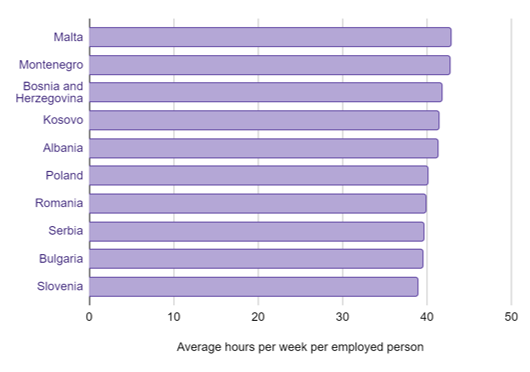A standard workweek is 40 hours long. This may vary slightly from country to country, as we take into account local labor laws, work culture, individual employer policies, and more. Plus, some employees may also work longer hours as part of their job, while others may work less.
In the United States, the federal overtime regulations are contained in the Fair Labor Standards Act (FLSA). Unless an employee is exempt, they are covered by the FLSA to receive overtime pay in the amount not less than time and one-half their regular rates of pay — provided they work over 40 hours a week.

Before we dive into the details of overtime terms, calculations and unexpected statistics, let’s make sure you are not underpaid for working beyond the standard working hours.
Are you a salaried or non-salaried employee? Choose the overtime pay calculator below according to your status.
Overtime pay calculator for non-salaried employees
If you’re paid by the hour and you know your hourly rate, simply enter it in the calculator below, along with the weekly hours stipulated in your contract and the actual hours you’ve worked.
Fill in your hourly rate, weekly hours by contract and weekly hours actually worked and you will see how much you’re supposed to get in overtime pay for overworked hours.
The standard overtime pay rate for non-salaried employees is 1.5 times their regular hourly wage. This means that for each hour worked beyond the established threshold, they are paid 1.5 times their normal hourly wage. This is also known as “time and a half”.
What is time and a half?
“Time and a half” refers to a pay rate that is one and a half times an employee’s regular hourly wage. This higher pay rate is typically used to compensate employees for working overtime hours, which are hours worked beyond the standard workweek or workday threshold set by labor laws.
Overtime pay calculator for salaried employees
Overtime pay for salaried employees can be more complex than for hourly employees due to the exempt and non-exempt classification under labor laws. Salaried employees who are classified as “exempt” are typically not entitled to receive overtime pay, while those classified as “non-exempt” are eligible for overtime pay when they work beyond certain thresholds.
Here’s how overtime pay works for salaried employees in both classifications:
Exempt Salaried Employees
Exempt salaried employees are typically those in executive, administrative, professional, and certain other specialized roles. These employees are not entitled to overtime pay regardless of the number of hours they work beyond their standard working hours. They receive a fixed salary regardless of the number of hours worked.
Exempt employees are paid for their job responsibilities rather than for the hours worked. They are often expected to work additional hours as needed without receiving additional compensation beyond their salary.
Non-Exempt Salaried Employees
Non-exempt salaried employees are entitled to overtime pay when they work beyond a certain threshold, just like hourly employees. These employees are typically in roles that do not fall under the exempt categories defined by labor laws.
For non-exempt salaried employees, overtime pay is calculated based on their regular hourly rate, even though they receive a salary. The process involves determining their hourly rate by dividing their weekly salary by the number of hours in a standard workweek (usually 40 hours). Then, any hours worked beyond 40 hours in a week are paid at the overtime rate, which is usually 1.5 times their regular hourly rate.
Fill in your monthly salary, weekly hours by contract and weekly hours actually worked and you will see how much you’re supposed to get in overtime pay for overworked hours.
How much is my overtime pay rate?
Is it always as simple as to multiply the overtime rate by 1.5?
No, you should multiply your regular hourly rate by 2.0 when you exceed 12 hours on any workday or work more than 8 hours on the seventh day of the workweek.
So, if your standard hourly wage is $15, your regular overtime rate (1.5x) would be $22.50 per hour.
For overtime worked beyond 12 consecutive hours (and beyond 8 hours on the seventh workday), the rate would be $30 per hour.
In this case, use this Calculator:
Am I eligible for overtime pay?
Employees under the FLSA fall into two categories: “exempt” and “nonexempt.” Nonexempt employees are eligible for overtime pay, while exempt employees are not. The majority of FLSA-covered employees are in the nonexempt category, but some are not.
Certain jobs are automatically considered exempt. For instance, “outside sales” employees are exempt, while “inside sales” employees are nonexempt. However, for most employees, whether they are exempt or nonexempt depends on:
- their salary,
- how they are paid,
- the nature of their work.
In general, for an employee to be considered exempt, they must:
- earn at least $23,600 annually ($455 per week),
- receive a salary,
- perform job duties that meet the criteria specified in the FLSA Regulations set by the U.S. Department of Labor.
In most cases, meeting all three of these conditions is necessary for exemption.
Eligible for overtime pay
The majority of employees protected by the FLSA can qualify for overtime compensation.
This applies to both salaried and hourly employees as long as they meet the FLSA criteria mentioned earlier. Here are a few examples of eligible workers:
- Freelancers
- Interns
- Retail staff
- Contractors, and so on.
Non-eligible for overtime pay
Those who do not qualify for overtime pay are commonly referred to as “exempt” because they are exempt from these regulations. This group includes:
- Salaried employees earning over $684 per week or more than $35,568 per year.
- Professionals in “white-collar” roles, such as managers, administrators, and desk job workers.
- Seasonal employees.
- Independent contractors, and more.
For a comprehensive list of professions that do not qualify for overtime pay, you can consult the document provided by the U.S. Department of Labor.
Working beyond regular hours without receiving additional compensation, known as “working off the clock,” can lead to potential issues for both employees and employers. It’s important to stay informed about federal and state laws and regulations to ensure compliance.
In what countries do people have the longest work hours per week?
Throughout history, individuals have strived to secure their labor rights, with many European and American nations notably reducing their work hours significantly. Nevertheless, numerous countries continue to have workweeks that far exceed the typical 40-hour norm. Take a look at the chart below to identify the top 10 countries where weekly work hours are notably extended.
Top 10 Countries with the longest work hours per week
When it comes to European nations, you might assume that overtime work is uncommon due to the historical labor rights movements. Nevertheless, there are still European countries where the standard 40-hour workweek is regularly exceeded. To gain insights into European countries with extended work hours, take a look at the chart provided below.
TOP 10 European countries with the longest work hours per week

Meanwhile, Austria, France and the Netherlands are the countries with the shortest work hours per week. Here is how they compare to Canada, Australia and the US.

The average working hours vary depending on the industry. As shown in the table below, the industries exceeding 40 working hours per week in 2023 are mining and logging, manufacturing durable goods and utilities.
Is Working Overtime Worth It?
This depends on a few things.
Overtime work does come with its own set of undeniable benefits.
- First, overtime work comes with overtime pay. In most cases, working overtime means you will be making 1.5 to 2 times your regular hourly rate. Needless to say, this is a great way to make more money to cover your expenses: everyday spending, travel, savings, etc.
- Second, working overtime can help you get promoted. By consistently taking on extra hours, you will show your employer that you are reliable and committed to your role. This will translate into a good reputation at work and, hopefully, lead to new opportunities and maybe even a pay raise.
- Finally, overtime gives you a chance to get more valuable work experience and improve your skill set. As you spend more time at work completing tasks and projects, you naturally become better at what you do. This hands-on experience can contribute to your professional development and make you more skilled in your field.
Then again, working overtime isn’t without downsides.
- Working long hours often leads to decreased levels of concentration. As you spend more time at your desk, you may find it more and more challenging to stay focused and productive. And this means you may need to start taking more breaks.
- Depending on what you do, longer hours can also come with health and safety risks. Regularly spending too much time at work can have a negative impact on your work-life balance, increase the risk of burnout, and even affect your health. This is especially true if your job involves spending long hours in front of the computer. To address these risks, some companies have limitations in place when it comes to working hours – specifically, in roles such as truck driving.
- With only 24 hours in a day, working overtime will often leave you with less time for your life outside of work. This means less time spent with family and friends, less time for hobbies, travel, the gym, etc.
How to decide if you should work overtime
Whether or not you should take on overtime work is a very personal decision. But there are some helpful practices that can help you arrive at the right conclusion.
- Start by reviewing your company’s policies when it comes to overtime work and overtime pay. Some organizations may have caps in place on weekly overtime hours. Learn about your company’s overtime policies and ask your HR manager for details.
- Take a look at your schedule and tasks. Look for projects or time periods that may require you to commit additional hours. Evaluate and plan your potential overtime: make sure your extra working hours translate into better productivity, as opposed to stress and burnout.
- Find out when you are most productive during the day. If you learn that you get more done in the morning, use these hours for overtime work. Knowing your peak productivity times can help you stay focused throughout your regular working day as well as overtime hours.
- Do you need an extra source of income? Working overtime can often be an easier way to boost your earnings without the need to look for a second job and adjust to a new environment and responsibilities.
- Before you commit to a schedule that includes overtime, check whether extra hours are something your manager will appreciate. If you notice that your colleagues are getting promoted and recognized for taking on extra work, this may be a clear sign that your hard work could lead to more opportunities.
3 Best tips for working overtime
Don’t go overboard with overtime
Getting to work at 8 AM and leaving at 7 PM every day may indeed show your manager that you are a dedicated employee. But it’s important to not make it a routine practice.
In some cases, working longer hours can come with more cons than pros. For instance, it could inspire questions about time management skills.
Working overtime consistently can sometimes have adverse consequences. This may happen if your overtime efforts go from being appreciated to being expected by management. Do your best to approach overtime as an exception rather than the norm and strategically plan out your additional hours. A suitable example would be staying late during critical moments for the company, such as handling major accounts or navigating through a crisis.
Ensure you get the recognition you deserve.
You may be taking on extra hours to cope with deadlines. However, these extra efforts on your part may feel unrewarding if they are not recognized by your management. It gets even worse if your employer occasionally uses specific tactics to avoid paying overtime. This may be asking you to work “off the clock,” expecting you to be on call after work hours, taking work home, etc.
Even if you prefer not to say it outright, the reason you are working overtime is probably because you want to be recognized for your work. But if your efforts go unnoticed, you may never get the appreciation you deserve.
Say, there is no one else around in the office. There are a few ways to make sure your superiors recognize you are staying after hours:
- You can send a time-stamped email from the office to your boss or leave a note on their desk (only if you have a legitimate reason to do so, of course).
- You can also suggest that your office starts using time tracking software. This way, all the hours and minutes you put in at the office are accounted for.
Be honest with yourself and with your boss about your productive hours.
Some people are more productive in the afternoon, or even in the evening. If this is when your productivity peaks, you will naturally feel happier, more creative and enthusiastic when doing your job.
If this is the case, it may be a good idea to talk to your manager about the possibility of adjusting your work hours. For example, you may ask to come in later and extend your afternoon work hours. Your schedule can be even more flexible if you have the privilege of remote work.
Ultimately, as long as you meet your deadline and keep up the quality of your work, your boss should be open to this arrangement.

